Emotional Intelligence and Leadership Report for BSBLDR501
VerifiedAdded on 2023/06/10
|11
|2754
|199
Report
AI Summary
This report examines the multifaceted aspects of emotional intelligence (EI) within a leadership context, addressing its significance in fostering effective workplace dynamics. The report begins by defining EI, outlining the principles of self-regulation and self-awareness, and then delves into the relationship between emotionally intelligent leaders and their capacity to inspire employees towards achieving business goals. It further explores strategies for communicating with a diverse workforce, considering cultural variations in emotional expression. The report also highlights the role of EI in building strong workplace relationships and managing stress and conflict. A project component assesses the individual's strengths and weaknesses related to EI, identifies personal stressors, and explores emotional triggers and their management. The report concludes by emphasizing the importance of EI in various leadership scenarios, including role modeling, feedback reception, and creating a positive emotional climate, providing valuable insights for aspiring departmental managers.
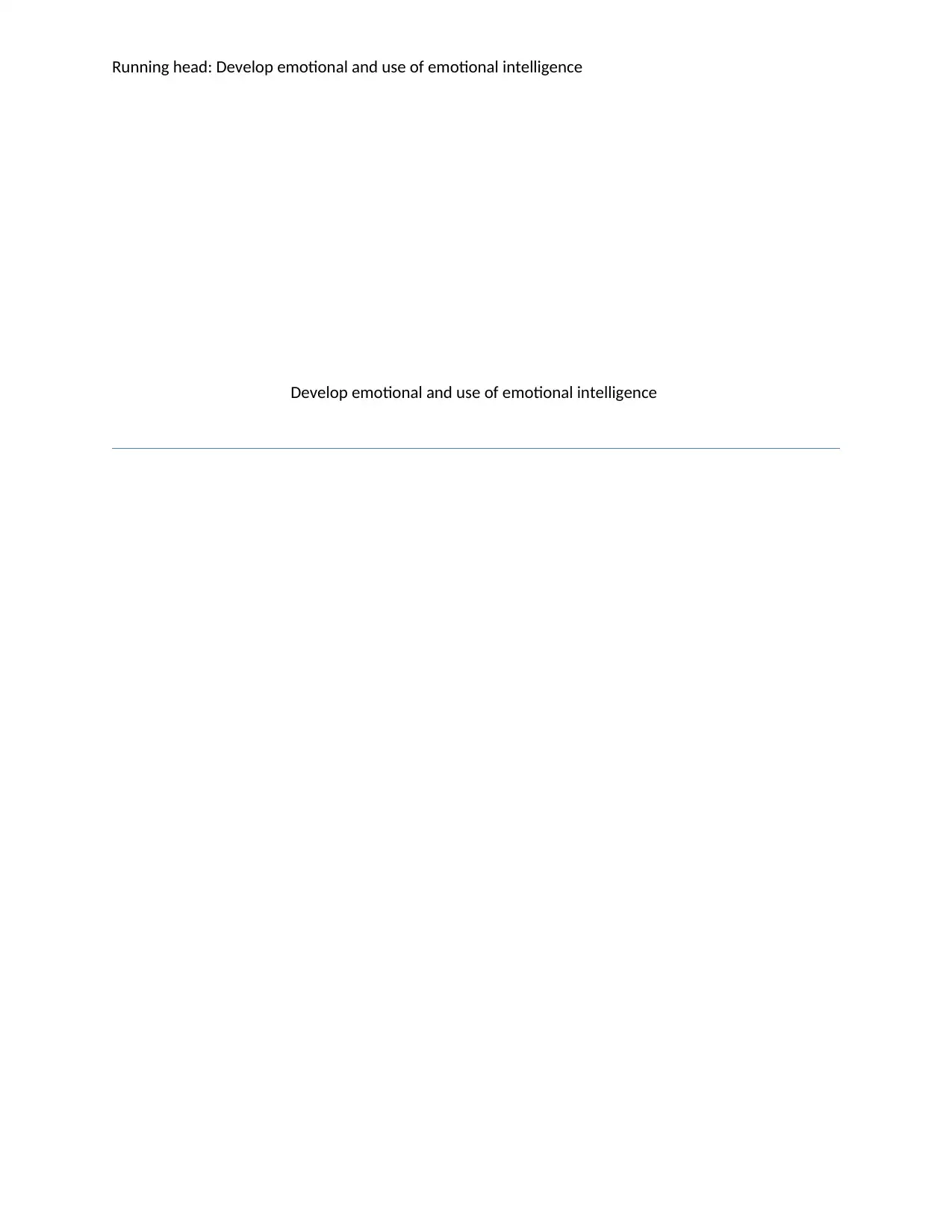
Running head: Develop emotional and use of emotional intelligence
Develop emotional and use of emotional intelligence
Develop emotional and use of emotional intelligence
Paraphrase This Document
Need a fresh take? Get an instant paraphrase of this document with our AI Paraphraser
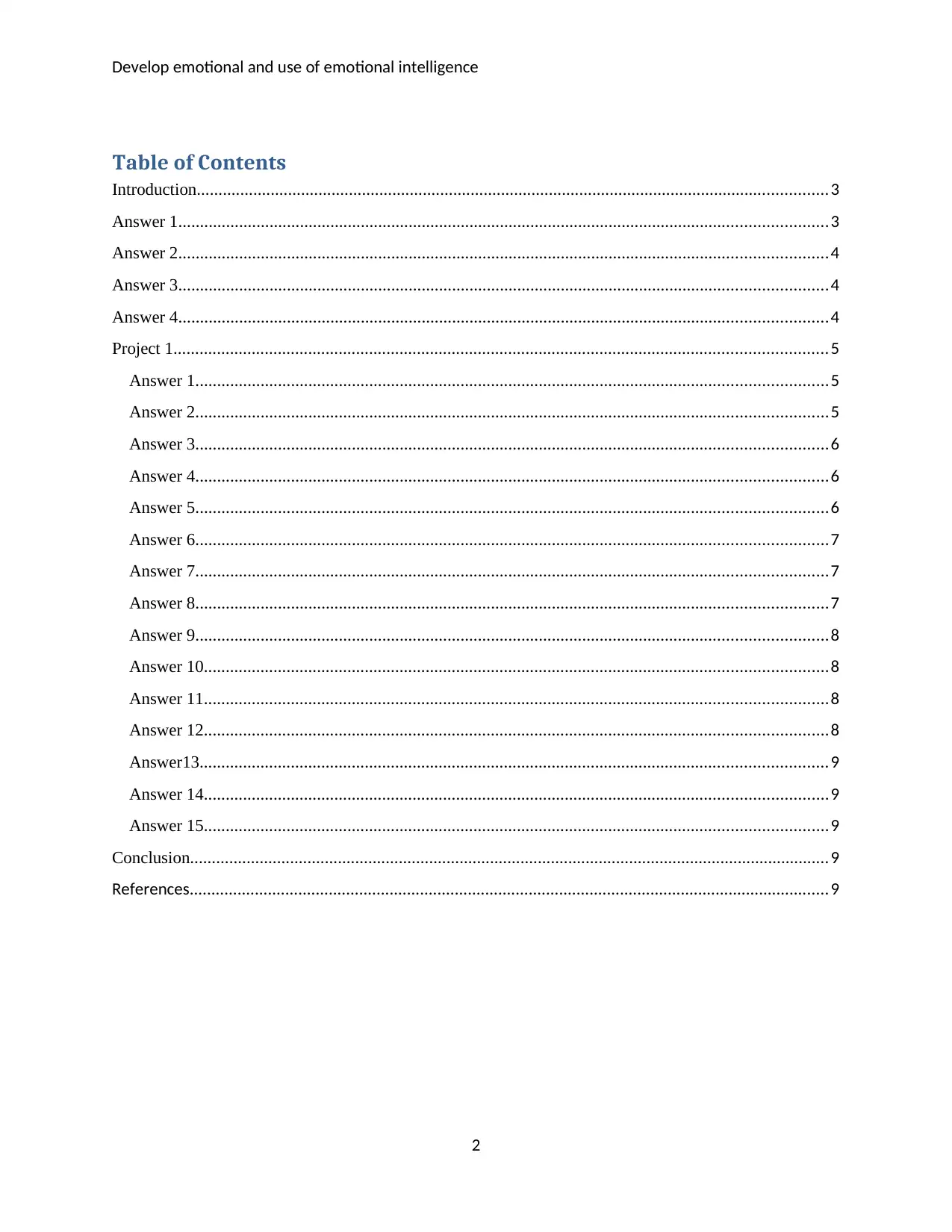
Develop emotional and use of emotional intelligence
Table of Contents
Introduction.................................................................................................................................................3
Answer 1.....................................................................................................................................................3
Answer 2.....................................................................................................................................................4
Answer 3.....................................................................................................................................................4
Answer 4.....................................................................................................................................................4
Project 1......................................................................................................................................................5
Answer 1.................................................................................................................................................5
Answer 2.................................................................................................................................................5
Answer 3.................................................................................................................................................6
Answer 4.................................................................................................................................................6
Answer 5.................................................................................................................................................6
Answer 6.................................................................................................................................................7
Answer 7.................................................................................................................................................7
Answer 8.................................................................................................................................................7
Answer 9.................................................................................................................................................8
Answer 10...............................................................................................................................................8
Answer 11...............................................................................................................................................8
Answer 12...............................................................................................................................................8
Answer13................................................................................................................................................9
Answer 14...............................................................................................................................................9
Answer 15...............................................................................................................................................9
Conclusion...................................................................................................................................................9
References...................................................................................................................................................9
2
Table of Contents
Introduction.................................................................................................................................................3
Answer 1.....................................................................................................................................................3
Answer 2.....................................................................................................................................................4
Answer 3.....................................................................................................................................................4
Answer 4.....................................................................................................................................................4
Project 1......................................................................................................................................................5
Answer 1.................................................................................................................................................5
Answer 2.................................................................................................................................................5
Answer 3.................................................................................................................................................6
Answer 4.................................................................................................................................................6
Answer 5.................................................................................................................................................6
Answer 6.................................................................................................................................................7
Answer 7.................................................................................................................................................7
Answer 8.................................................................................................................................................7
Answer 9.................................................................................................................................................8
Answer 10...............................................................................................................................................8
Answer 11...............................................................................................................................................8
Answer 12...............................................................................................................................................8
Answer13................................................................................................................................................9
Answer 14...............................................................................................................................................9
Answer 15...............................................................................................................................................9
Conclusion...................................................................................................................................................9
References...................................................................................................................................................9
2
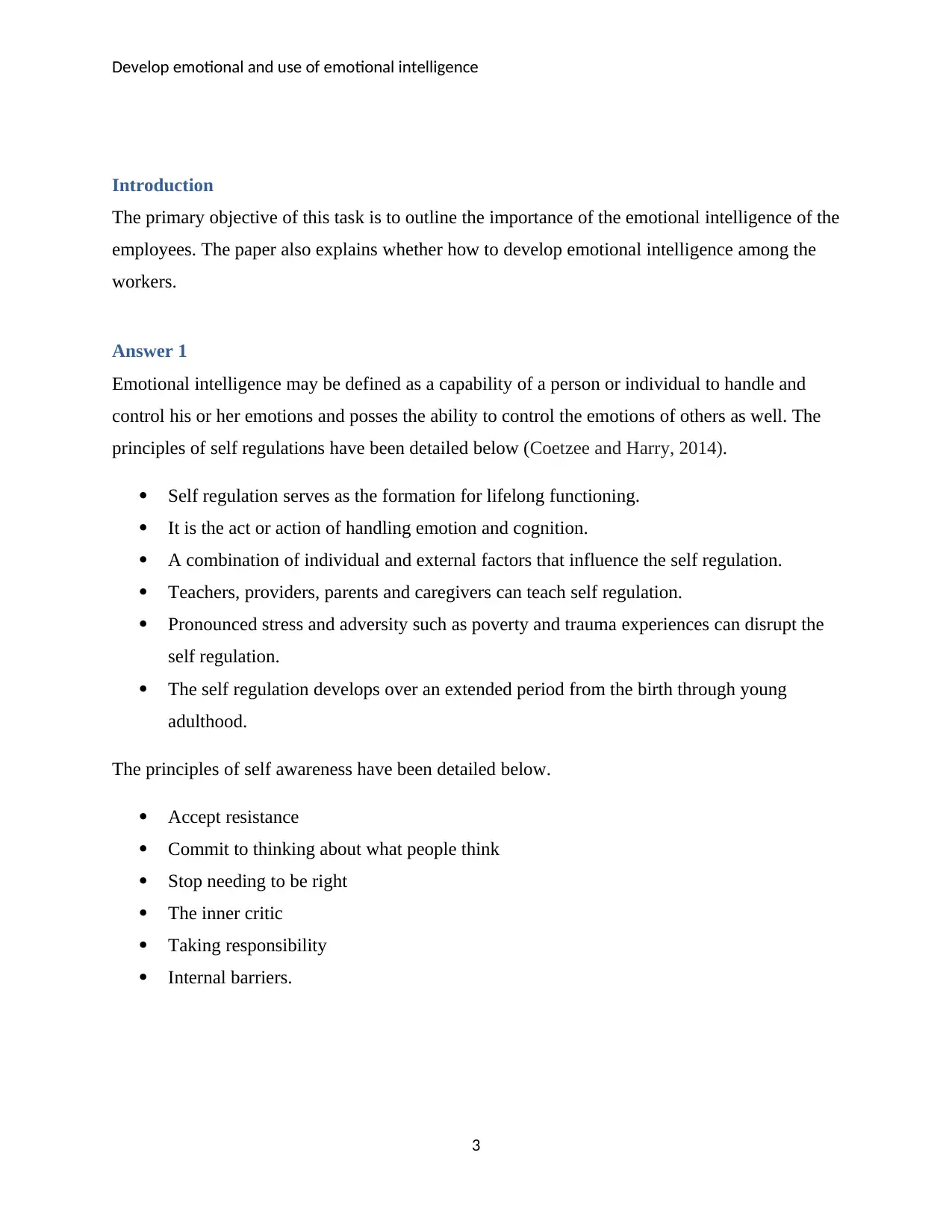
Develop emotional and use of emotional intelligence
Introduction
The primary objective of this task is to outline the importance of the emotional intelligence of the
employees. The paper also explains whether how to develop emotional intelligence among the
workers.
Answer 1
Emotional intelligence may be defined as a capability of a person or individual to handle and
control his or her emotions and posses the ability to control the emotions of others as well. The
principles of self regulations have been detailed below (Coetzee and Harry, 2014).
Self regulation serves as the formation for lifelong functioning.
It is the act or action of handling emotion and cognition.
A combination of individual and external factors that influence the self regulation.
Teachers, providers, parents and caregivers can teach self regulation.
Pronounced stress and adversity such as poverty and trauma experiences can disrupt the
self regulation.
The self regulation develops over an extended period from the birth through young
adulthood.
The principles of self awareness have been detailed below.
Accept resistance
Commit to thinking about what people think
Stop needing to be right
The inner critic
Taking responsibility
Internal barriers.
3
Introduction
The primary objective of this task is to outline the importance of the emotional intelligence of the
employees. The paper also explains whether how to develop emotional intelligence among the
workers.
Answer 1
Emotional intelligence may be defined as a capability of a person or individual to handle and
control his or her emotions and posses the ability to control the emotions of others as well. The
principles of self regulations have been detailed below (Coetzee and Harry, 2014).
Self regulation serves as the formation for lifelong functioning.
It is the act or action of handling emotion and cognition.
A combination of individual and external factors that influence the self regulation.
Teachers, providers, parents and caregivers can teach self regulation.
Pronounced stress and adversity such as poverty and trauma experiences can disrupt the
self regulation.
The self regulation develops over an extended period from the birth through young
adulthood.
The principles of self awareness have been detailed below.
Accept resistance
Commit to thinking about what people think
Stop needing to be right
The inner critic
Taking responsibility
Internal barriers.
3
⊘ This is a preview!⊘
Do you want full access?
Subscribe today to unlock all pages.

Trusted by 1+ million students worldwide
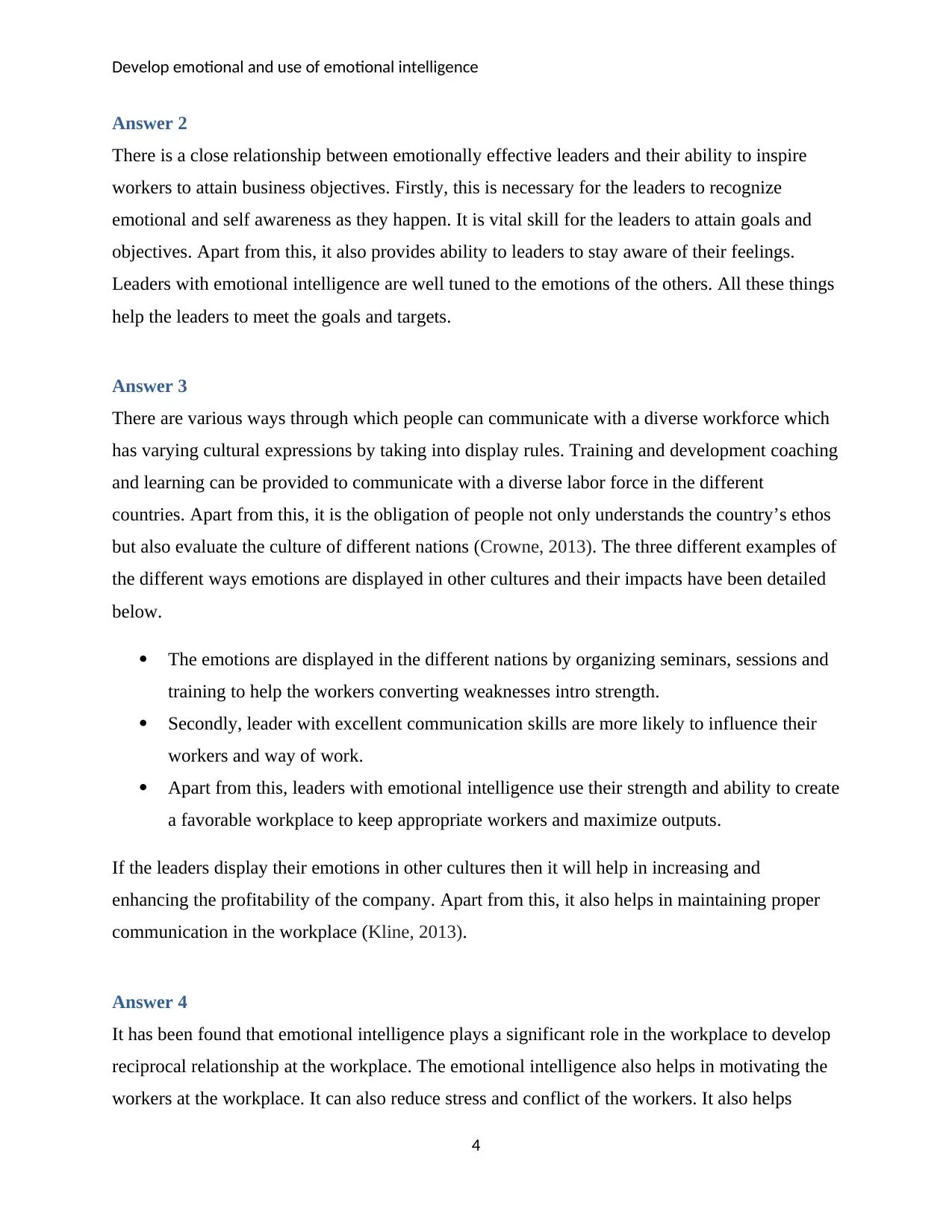
Develop emotional and use of emotional intelligence
Answer 2
There is a close relationship between emotionally effective leaders and their ability to inspire
workers to attain business objectives. Firstly, this is necessary for the leaders to recognize
emotional and self awareness as they happen. It is vital skill for the leaders to attain goals and
objectives. Apart from this, it also provides ability to leaders to stay aware of their feelings.
Leaders with emotional intelligence are well tuned to the emotions of the others. All these things
help the leaders to meet the goals and targets.
Answer 3
There are various ways through which people can communicate with a diverse workforce which
has varying cultural expressions by taking into display rules. Training and development coaching
and learning can be provided to communicate with a diverse labor force in the different
countries. Apart from this, it is the obligation of people not only understands the country’s ethos
but also evaluate the culture of different nations (Crowne, 2013). The three different examples of
the different ways emotions are displayed in other cultures and their impacts have been detailed
below.
The emotions are displayed in the different nations by organizing seminars, sessions and
training to help the workers converting weaknesses intro strength.
Secondly, leader with excellent communication skills are more likely to influence their
workers and way of work.
Apart from this, leaders with emotional intelligence use their strength and ability to create
a favorable workplace to keep appropriate workers and maximize outputs.
If the leaders display their emotions in other cultures then it will help in increasing and
enhancing the profitability of the company. Apart from this, it also helps in maintaining proper
communication in the workplace (Kline, 2013).
Answer 4
It has been found that emotional intelligence plays a significant role in the workplace to develop
reciprocal relationship at the workplace. The emotional intelligence also helps in motivating the
workers at the workplace. It can also reduce stress and conflict of the workers. It also helps
4
Answer 2
There is a close relationship between emotionally effective leaders and their ability to inspire
workers to attain business objectives. Firstly, this is necessary for the leaders to recognize
emotional and self awareness as they happen. It is vital skill for the leaders to attain goals and
objectives. Apart from this, it also provides ability to leaders to stay aware of their feelings.
Leaders with emotional intelligence are well tuned to the emotions of the others. All these things
help the leaders to meet the goals and targets.
Answer 3
There are various ways through which people can communicate with a diverse workforce which
has varying cultural expressions by taking into display rules. Training and development coaching
and learning can be provided to communicate with a diverse labor force in the different
countries. Apart from this, it is the obligation of people not only understands the country’s ethos
but also evaluate the culture of different nations (Crowne, 2013). The three different examples of
the different ways emotions are displayed in other cultures and their impacts have been detailed
below.
The emotions are displayed in the different nations by organizing seminars, sessions and
training to help the workers converting weaknesses intro strength.
Secondly, leader with excellent communication skills are more likely to influence their
workers and way of work.
Apart from this, leaders with emotional intelligence use their strength and ability to create
a favorable workplace to keep appropriate workers and maximize outputs.
If the leaders display their emotions in other cultures then it will help in increasing and
enhancing the profitability of the company. Apart from this, it also helps in maintaining proper
communication in the workplace (Kline, 2013).
Answer 4
It has been found that emotional intelligence plays a significant role in the workplace to develop
reciprocal relationship at the workplace. The emotional intelligence also helps in motivating the
workers at the workplace. It can also reduce stress and conflict of the workers. It also helps
4
Paraphrase This Document
Need a fresh take? Get an instant paraphrase of this document with our AI Paraphraser
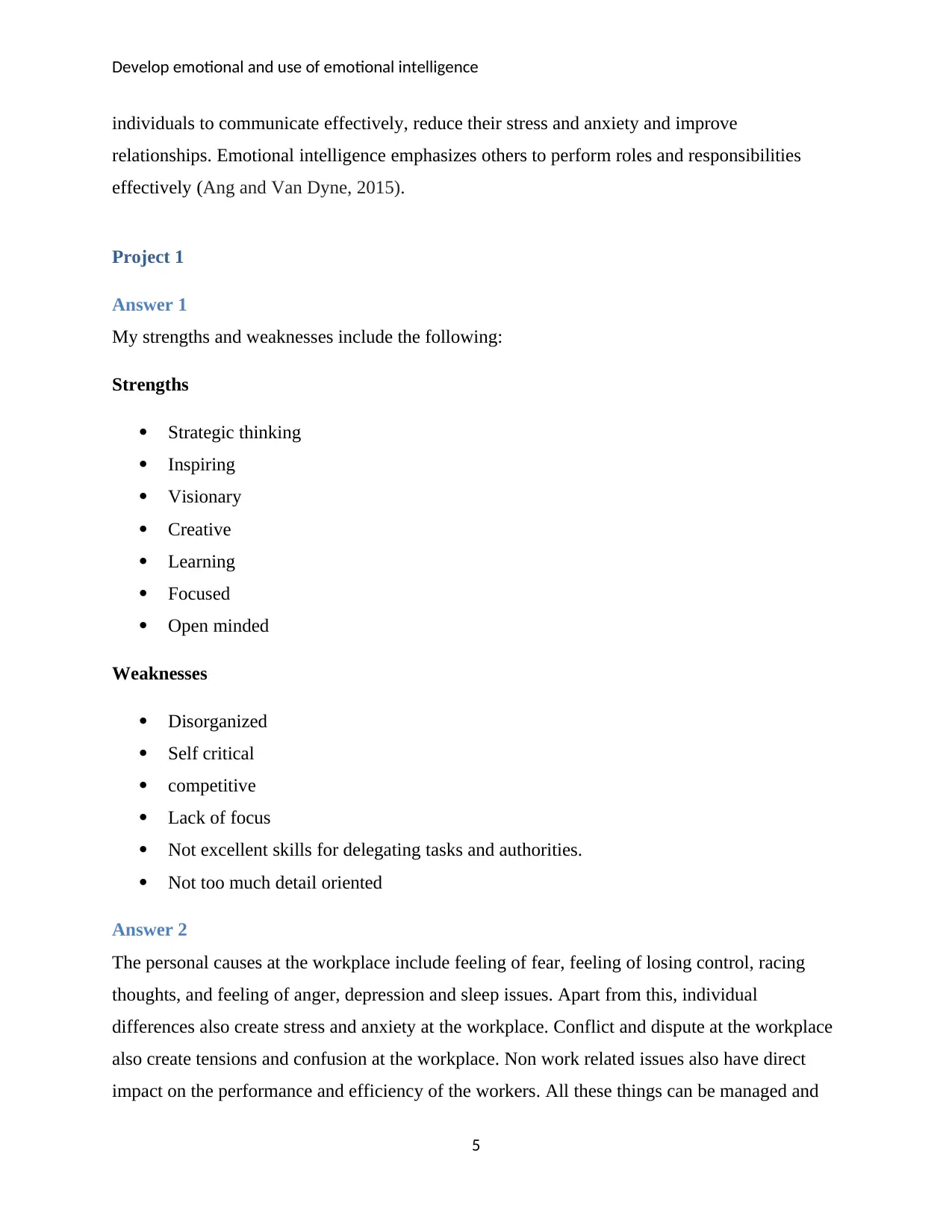
Develop emotional and use of emotional intelligence
individuals to communicate effectively, reduce their stress and anxiety and improve
relationships. Emotional intelligence emphasizes others to perform roles and responsibilities
effectively (Ang and Van Dyne, 2015).
Project 1
Answer 1
My strengths and weaknesses include the following:
Strengths
Strategic thinking
Inspiring
Visionary
Creative
Learning
Focused
Open minded
Weaknesses
Disorganized
Self critical
competitive
Lack of focus
Not excellent skills for delegating tasks and authorities.
Not too much detail oriented
Answer 2
The personal causes at the workplace include feeling of fear, feeling of losing control, racing
thoughts, and feeling of anger, depression and sleep issues. Apart from this, individual
differences also create stress and anxiety at the workplace. Conflict and dispute at the workplace
also create tensions and confusion at the workplace. Non work related issues also have direct
impact on the performance and efficiency of the workers. All these things can be managed and
5
individuals to communicate effectively, reduce their stress and anxiety and improve
relationships. Emotional intelligence emphasizes others to perform roles and responsibilities
effectively (Ang and Van Dyne, 2015).
Project 1
Answer 1
My strengths and weaknesses include the following:
Strengths
Strategic thinking
Inspiring
Visionary
Creative
Learning
Focused
Open minded
Weaknesses
Disorganized
Self critical
competitive
Lack of focus
Not excellent skills for delegating tasks and authorities.
Not too much detail oriented
Answer 2
The personal causes at the workplace include feeling of fear, feeling of losing control, racing
thoughts, and feeling of anger, depression and sleep issues. Apart from this, individual
differences also create stress and anxiety at the workplace. Conflict and dispute at the workplace
also create tensions and confusion at the workplace. Non work related issues also have direct
impact on the performance and efficiency of the workers. All these things can be managed and
5
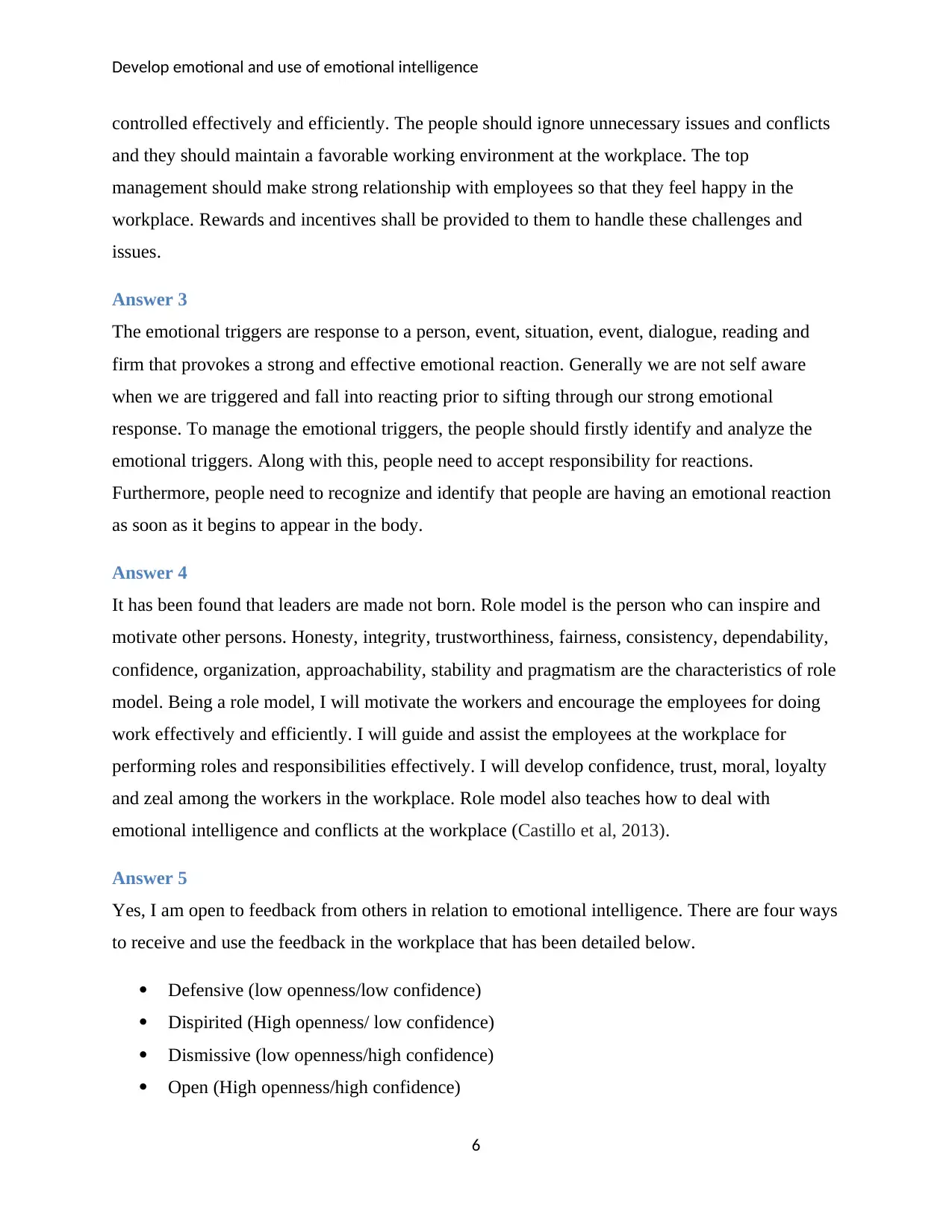
Develop emotional and use of emotional intelligence
controlled effectively and efficiently. The people should ignore unnecessary issues and conflicts
and they should maintain a favorable working environment at the workplace. The top
management should make strong relationship with employees so that they feel happy in the
workplace. Rewards and incentives shall be provided to them to handle these challenges and
issues.
Answer 3
The emotional triggers are response to a person, event, situation, event, dialogue, reading and
firm that provokes a strong and effective emotional reaction. Generally we are not self aware
when we are triggered and fall into reacting prior to sifting through our strong emotional
response. To manage the emotional triggers, the people should firstly identify and analyze the
emotional triggers. Along with this, people need to accept responsibility for reactions.
Furthermore, people need to recognize and identify that people are having an emotional reaction
as soon as it begins to appear in the body.
Answer 4
It has been found that leaders are made not born. Role model is the person who can inspire and
motivate other persons. Honesty, integrity, trustworthiness, fairness, consistency, dependability,
confidence, organization, approachability, stability and pragmatism are the characteristics of role
model. Being a role model, I will motivate the workers and encourage the employees for doing
work effectively and efficiently. I will guide and assist the employees at the workplace for
performing roles and responsibilities effectively. I will develop confidence, trust, moral, loyalty
and zeal among the workers in the workplace. Role model also teaches how to deal with
emotional intelligence and conflicts at the workplace (Castillo et al, 2013).
Answer 5
Yes, I am open to feedback from others in relation to emotional intelligence. There are four ways
to receive and use the feedback in the workplace that has been detailed below.
Defensive (low openness/low confidence)
Dispirited (High openness/ low confidence)
Dismissive (low openness/high confidence)
Open (High openness/high confidence)
6
controlled effectively and efficiently. The people should ignore unnecessary issues and conflicts
and they should maintain a favorable working environment at the workplace. The top
management should make strong relationship with employees so that they feel happy in the
workplace. Rewards and incentives shall be provided to them to handle these challenges and
issues.
Answer 3
The emotional triggers are response to a person, event, situation, event, dialogue, reading and
firm that provokes a strong and effective emotional reaction. Generally we are not self aware
when we are triggered and fall into reacting prior to sifting through our strong emotional
response. To manage the emotional triggers, the people should firstly identify and analyze the
emotional triggers. Along with this, people need to accept responsibility for reactions.
Furthermore, people need to recognize and identify that people are having an emotional reaction
as soon as it begins to appear in the body.
Answer 4
It has been found that leaders are made not born. Role model is the person who can inspire and
motivate other persons. Honesty, integrity, trustworthiness, fairness, consistency, dependability,
confidence, organization, approachability, stability and pragmatism are the characteristics of role
model. Being a role model, I will motivate the workers and encourage the employees for doing
work effectively and efficiently. I will guide and assist the employees at the workplace for
performing roles and responsibilities effectively. I will develop confidence, trust, moral, loyalty
and zeal among the workers in the workplace. Role model also teaches how to deal with
emotional intelligence and conflicts at the workplace (Castillo et al, 2013).
Answer 5
Yes, I am open to feedback from others in relation to emotional intelligence. There are four ways
to receive and use the feedback in the workplace that has been detailed below.
Defensive (low openness/low confidence)
Dispirited (High openness/ low confidence)
Dismissive (low openness/high confidence)
Open (High openness/high confidence)
6
⊘ This is a preview!⊘
Do you want full access?
Subscribe today to unlock all pages.

Trusted by 1+ million students worldwide
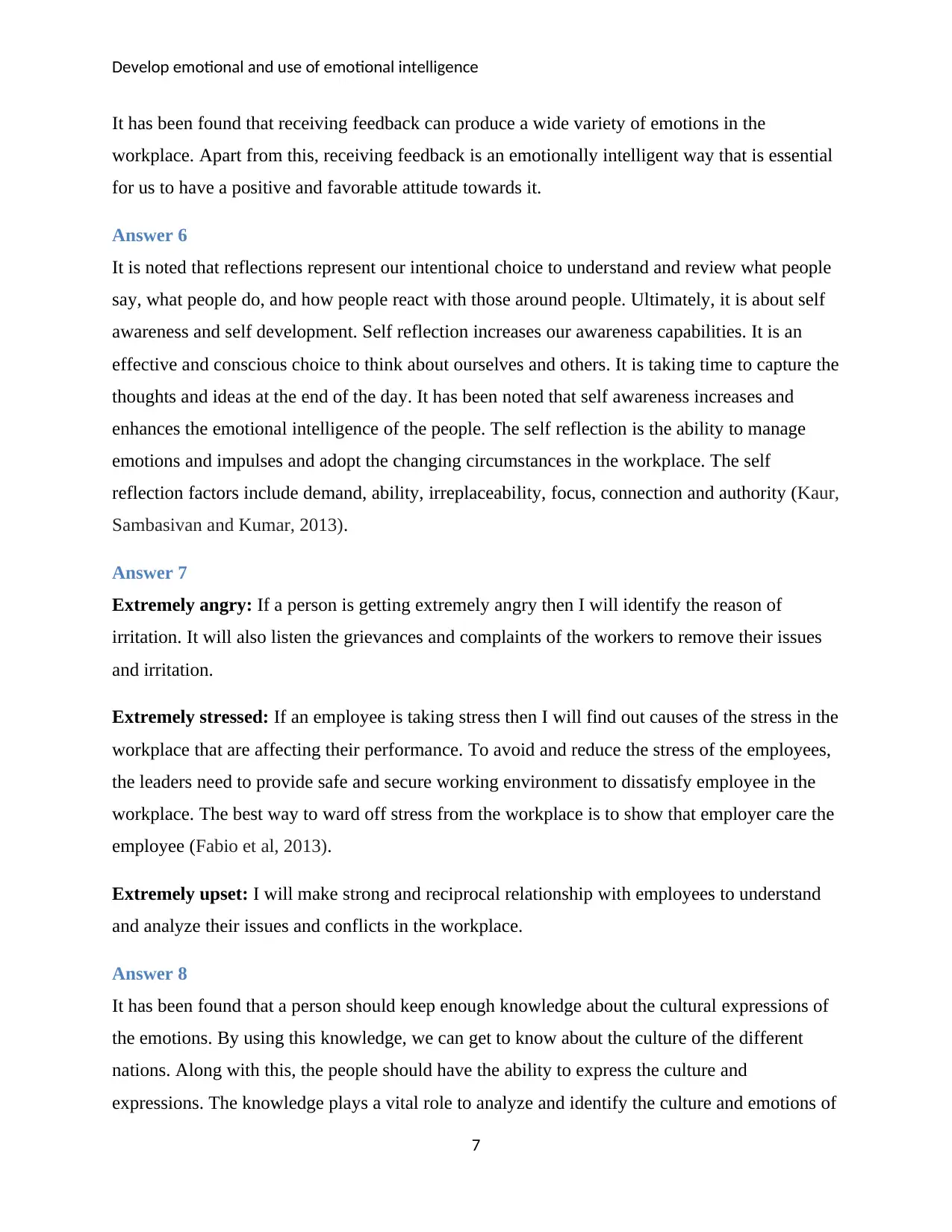
Develop emotional and use of emotional intelligence
It has been found that receiving feedback can produce a wide variety of emotions in the
workplace. Apart from this, receiving feedback is an emotionally intelligent way that is essential
for us to have a positive and favorable attitude towards it.
Answer 6
It is noted that reflections represent our intentional choice to understand and review what people
say, what people do, and how people react with those around people. Ultimately, it is about self
awareness and self development. Self reflection increases our awareness capabilities. It is an
effective and conscious choice to think about ourselves and others. It is taking time to capture the
thoughts and ideas at the end of the day. It has been noted that self awareness increases and
enhances the emotional intelligence of the people. The self reflection is the ability to manage
emotions and impulses and adopt the changing circumstances in the workplace. The self
reflection factors include demand, ability, irreplaceability, focus, connection and authority (Kaur,
Sambasivan and Kumar, 2013).
Answer 7
Extremely angry: If a person is getting extremely angry then I will identify the reason of
irritation. It will also listen the grievances and complaints of the workers to remove their issues
and irritation.
Extremely stressed: If an employee is taking stress then I will find out causes of the stress in the
workplace that are affecting their performance. To avoid and reduce the stress of the employees,
the leaders need to provide safe and secure working environment to dissatisfy employee in the
workplace. The best way to ward off stress from the workplace is to show that employer care the
employee (Fabio et al, 2013).
Extremely upset: I will make strong and reciprocal relationship with employees to understand
and analyze their issues and conflicts in the workplace.
Answer 8
It has been found that a person should keep enough knowledge about the cultural expressions of
the emotions. By using this knowledge, we can get to know about the culture of the different
nations. Along with this, the people should have the ability to express the culture and
expressions. The knowledge plays a vital role to analyze and identify the culture and emotions of
7
It has been found that receiving feedback can produce a wide variety of emotions in the
workplace. Apart from this, receiving feedback is an emotionally intelligent way that is essential
for us to have a positive and favorable attitude towards it.
Answer 6
It is noted that reflections represent our intentional choice to understand and review what people
say, what people do, and how people react with those around people. Ultimately, it is about self
awareness and self development. Self reflection increases our awareness capabilities. It is an
effective and conscious choice to think about ourselves and others. It is taking time to capture the
thoughts and ideas at the end of the day. It has been noted that self awareness increases and
enhances the emotional intelligence of the people. The self reflection is the ability to manage
emotions and impulses and adopt the changing circumstances in the workplace. The self
reflection factors include demand, ability, irreplaceability, focus, connection and authority (Kaur,
Sambasivan and Kumar, 2013).
Answer 7
Extremely angry: If a person is getting extremely angry then I will identify the reason of
irritation. It will also listen the grievances and complaints of the workers to remove their issues
and irritation.
Extremely stressed: If an employee is taking stress then I will find out causes of the stress in the
workplace that are affecting their performance. To avoid and reduce the stress of the employees,
the leaders need to provide safe and secure working environment to dissatisfy employee in the
workplace. The best way to ward off stress from the workplace is to show that employer care the
employee (Fabio et al, 2013).
Extremely upset: I will make strong and reciprocal relationship with employees to understand
and analyze their issues and conflicts in the workplace.
Answer 8
It has been found that a person should keep enough knowledge about the cultural expressions of
the emotions. By using this knowledge, we can get to know about the culture of the different
nations. Along with this, the people should have the ability to express the culture and
expressions. The knowledge plays a vital role to analyze and identify the culture and emotions of
7
Paraphrase This Document
Need a fresh take? Get an instant paraphrase of this document with our AI Paraphraser
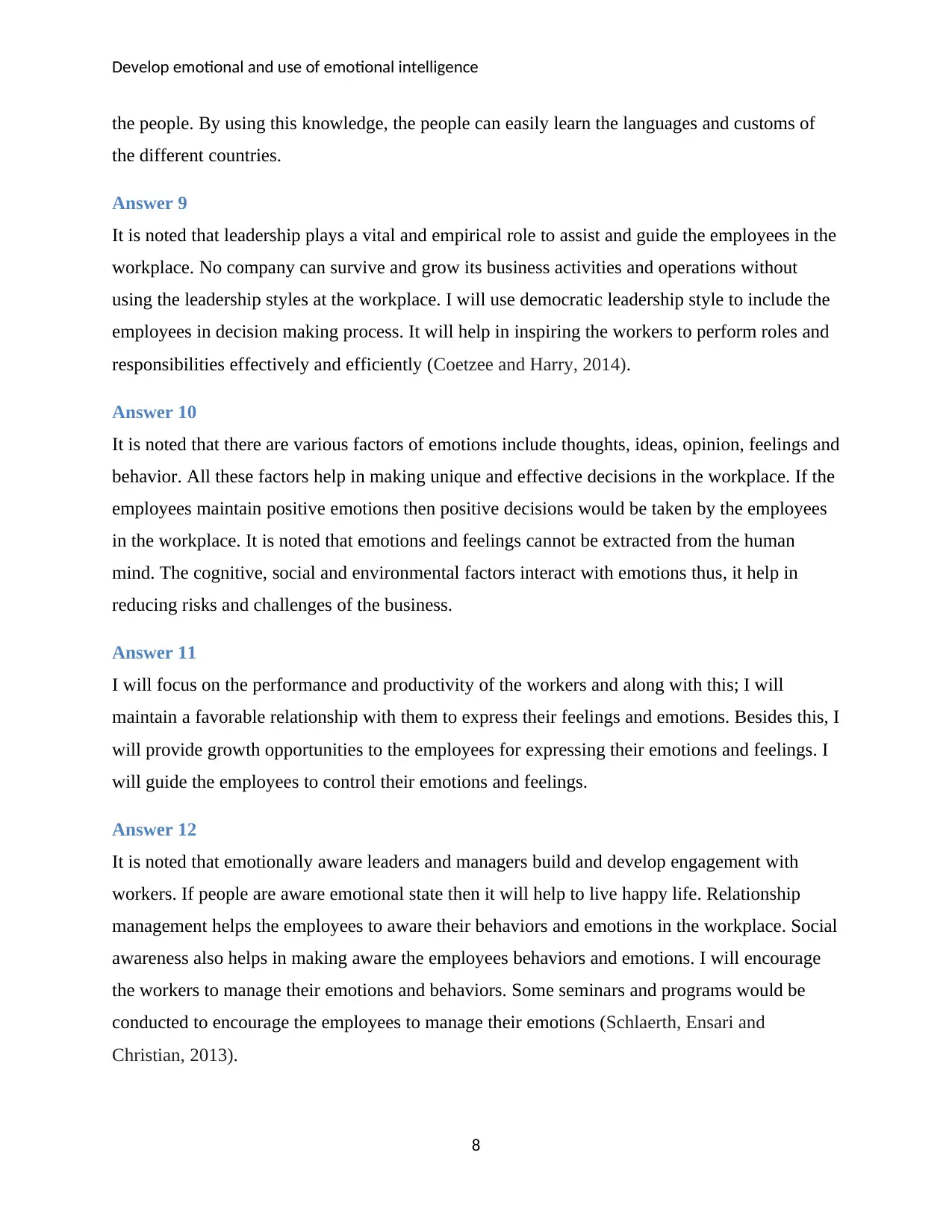
Develop emotional and use of emotional intelligence
the people. By using this knowledge, the people can easily learn the languages and customs of
the different countries.
Answer 9
It is noted that leadership plays a vital and empirical role to assist and guide the employees in the
workplace. No company can survive and grow its business activities and operations without
using the leadership styles at the workplace. I will use democratic leadership style to include the
employees in decision making process. It will help in inspiring the workers to perform roles and
responsibilities effectively and efficiently (Coetzee and Harry, 2014).
Answer 10
It is noted that there are various factors of emotions include thoughts, ideas, opinion, feelings and
behavior. All these factors help in making unique and effective decisions in the workplace. If the
employees maintain positive emotions then positive decisions would be taken by the employees
in the workplace. It is noted that emotions and feelings cannot be extracted from the human
mind. The cognitive, social and environmental factors interact with emotions thus, it help in
reducing risks and challenges of the business.
Answer 11
I will focus on the performance and productivity of the workers and along with this; I will
maintain a favorable relationship with them to express their feelings and emotions. Besides this, I
will provide growth opportunities to the employees for expressing their emotions and feelings. I
will guide the employees to control their emotions and feelings.
Answer 12
It is noted that emotionally aware leaders and managers build and develop engagement with
workers. If people are aware emotional state then it will help to live happy life. Relationship
management helps the employees to aware their behaviors and emotions in the workplace. Social
awareness also helps in making aware the employees behaviors and emotions. I will encourage
the workers to manage their emotions and behaviors. Some seminars and programs would be
conducted to encourage the employees to manage their emotions (Schlaerth, Ensari and
Christian, 2013).
8
the people. By using this knowledge, the people can easily learn the languages and customs of
the different countries.
Answer 9
It is noted that leadership plays a vital and empirical role to assist and guide the employees in the
workplace. No company can survive and grow its business activities and operations without
using the leadership styles at the workplace. I will use democratic leadership style to include the
employees in decision making process. It will help in inspiring the workers to perform roles and
responsibilities effectively and efficiently (Coetzee and Harry, 2014).
Answer 10
It is noted that there are various factors of emotions include thoughts, ideas, opinion, feelings and
behavior. All these factors help in making unique and effective decisions in the workplace. If the
employees maintain positive emotions then positive decisions would be taken by the employees
in the workplace. It is noted that emotions and feelings cannot be extracted from the human
mind. The cognitive, social and environmental factors interact with emotions thus, it help in
reducing risks and challenges of the business.
Answer 11
I will focus on the performance and productivity of the workers and along with this; I will
maintain a favorable relationship with them to express their feelings and emotions. Besides this, I
will provide growth opportunities to the employees for expressing their emotions and feelings. I
will guide the employees to control their emotions and feelings.
Answer 12
It is noted that emotionally aware leaders and managers build and develop engagement with
workers. If people are aware emotional state then it will help to live happy life. Relationship
management helps the employees to aware their behaviors and emotions in the workplace. Social
awareness also helps in making aware the employees behaviors and emotions. I will encourage
the workers to manage their emotions and behaviors. Some seminars and programs would be
conducted to encourage the employees to manage their emotions (Schlaerth, Ensari and
Christian, 2013).
8
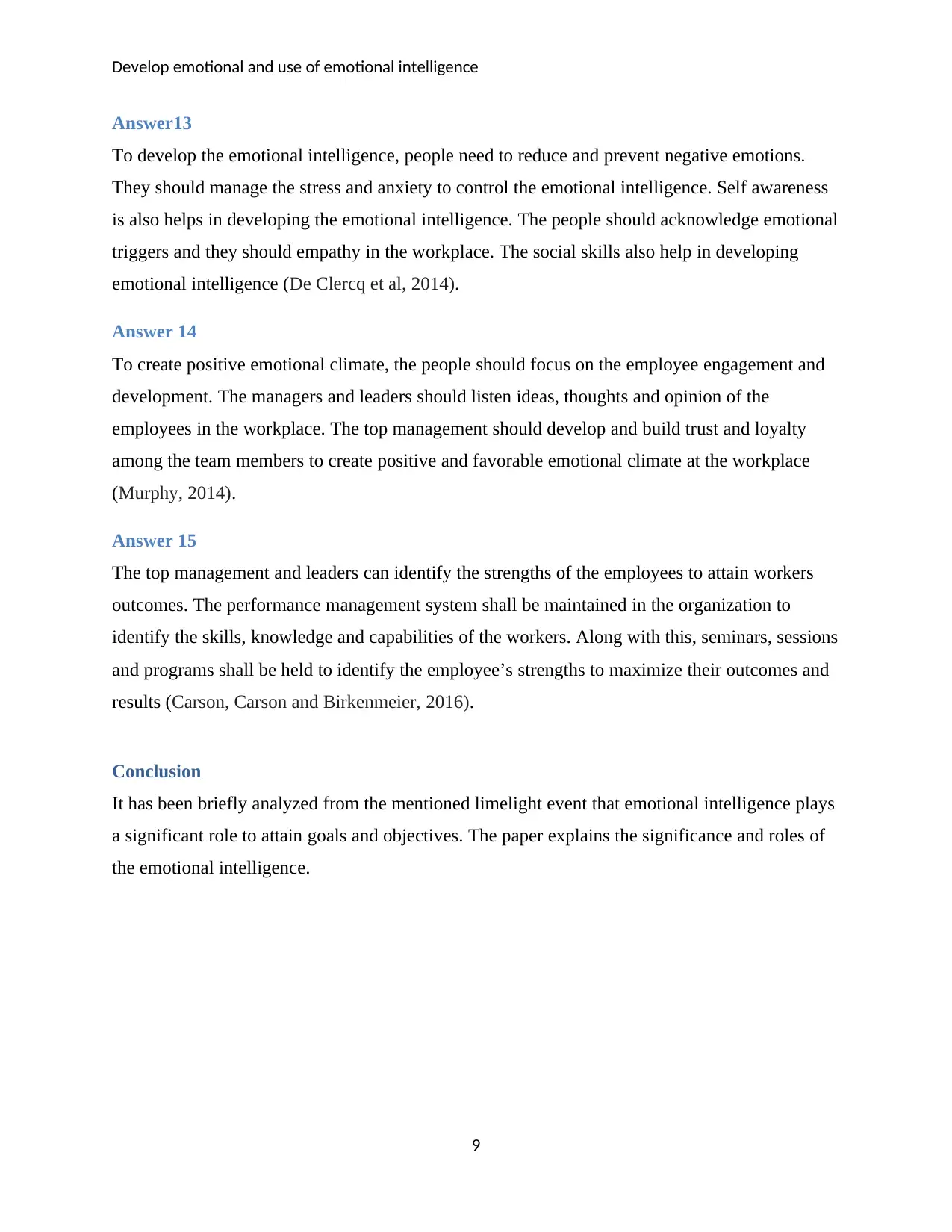
Develop emotional and use of emotional intelligence
Answer13
To develop the emotional intelligence, people need to reduce and prevent negative emotions.
They should manage the stress and anxiety to control the emotional intelligence. Self awareness
is also helps in developing the emotional intelligence. The people should acknowledge emotional
triggers and they should empathy in the workplace. The social skills also help in developing
emotional intelligence (De Clercq et al, 2014).
Answer 14
To create positive emotional climate, the people should focus on the employee engagement and
development. The managers and leaders should listen ideas, thoughts and opinion of the
employees in the workplace. The top management should develop and build trust and loyalty
among the team members to create positive and favorable emotional climate at the workplace
(Murphy, 2014).
Answer 15
The top management and leaders can identify the strengths of the employees to attain workers
outcomes. The performance management system shall be maintained in the organization to
identify the skills, knowledge and capabilities of the workers. Along with this, seminars, sessions
and programs shall be held to identify the employee’s strengths to maximize their outcomes and
results (Carson, Carson and Birkenmeier, 2016).
Conclusion
It has been briefly analyzed from the mentioned limelight event that emotional intelligence plays
a significant role to attain goals and objectives. The paper explains the significance and roles of
the emotional intelligence.
9
Answer13
To develop the emotional intelligence, people need to reduce and prevent negative emotions.
They should manage the stress and anxiety to control the emotional intelligence. Self awareness
is also helps in developing the emotional intelligence. The people should acknowledge emotional
triggers and they should empathy in the workplace. The social skills also help in developing
emotional intelligence (De Clercq et al, 2014).
Answer 14
To create positive emotional climate, the people should focus on the employee engagement and
development. The managers and leaders should listen ideas, thoughts and opinion of the
employees in the workplace. The top management should develop and build trust and loyalty
among the team members to create positive and favorable emotional climate at the workplace
(Murphy, 2014).
Answer 15
The top management and leaders can identify the strengths of the employees to attain workers
outcomes. The performance management system shall be maintained in the organization to
identify the skills, knowledge and capabilities of the workers. Along with this, seminars, sessions
and programs shall be held to identify the employee’s strengths to maximize their outcomes and
results (Carson, Carson and Birkenmeier, 2016).
Conclusion
It has been briefly analyzed from the mentioned limelight event that emotional intelligence plays
a significant role to attain goals and objectives. The paper explains the significance and roles of
the emotional intelligence.
9
⊘ This is a preview!⊘
Do you want full access?
Subscribe today to unlock all pages.

Trusted by 1+ million students worldwide
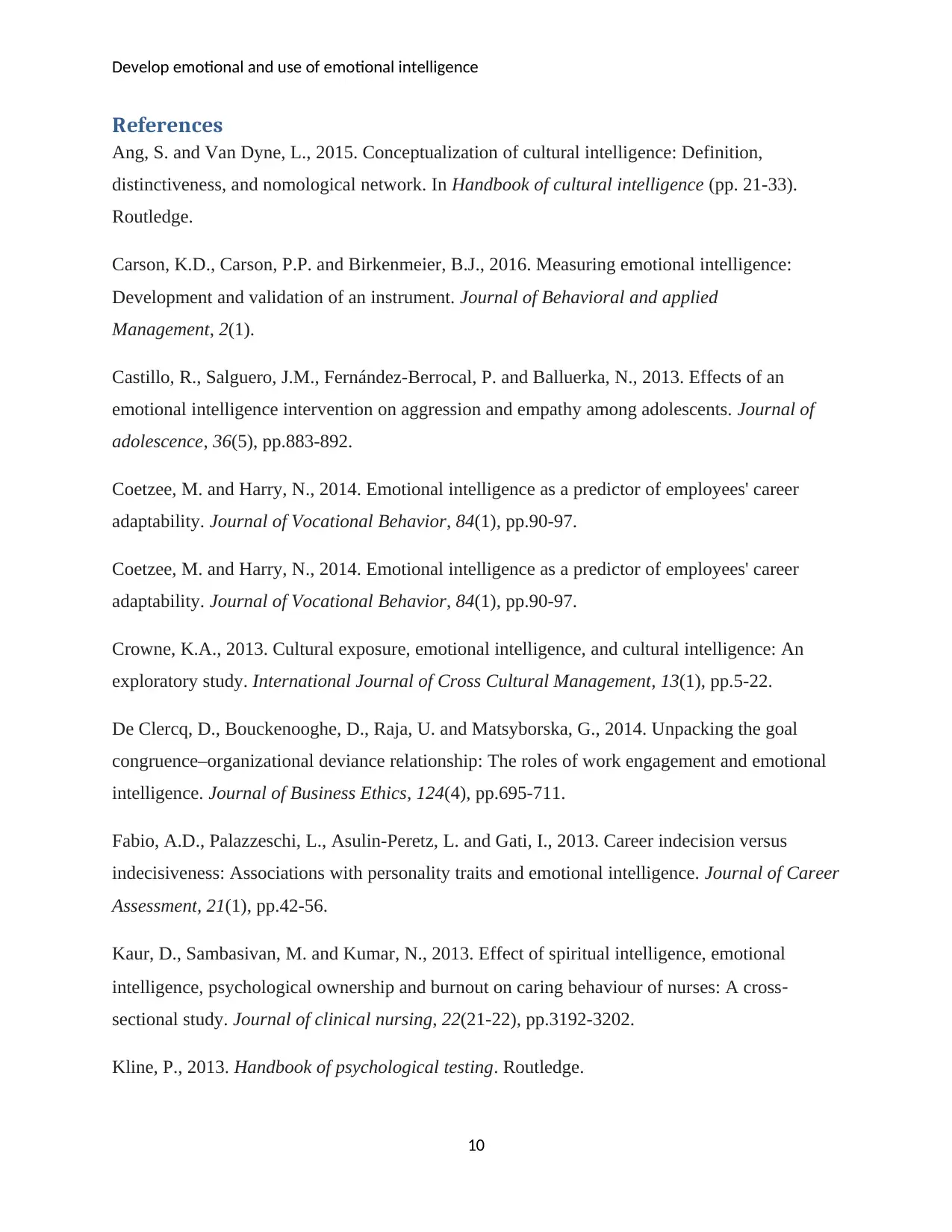
Develop emotional and use of emotional intelligence
References
Ang, S. and Van Dyne, L., 2015. Conceptualization of cultural intelligence: Definition,
distinctiveness, and nomological network. In Handbook of cultural intelligence (pp. 21-33).
Routledge.
Carson, K.D., Carson, P.P. and Birkenmeier, B.J., 2016. Measuring emotional intelligence:
Development and validation of an instrument. Journal of Behavioral and applied
Management, 2(1).
Castillo, R., Salguero, J.M., Fernández-Berrocal, P. and Balluerka, N., 2013. Effects of an
emotional intelligence intervention on aggression and empathy among adolescents. Journal of
adolescence, 36(5), pp.883-892.
Coetzee, M. and Harry, N., 2014. Emotional intelligence as a predictor of employees' career
adaptability. Journal of Vocational Behavior, 84(1), pp.90-97.
Coetzee, M. and Harry, N., 2014. Emotional intelligence as a predictor of employees' career
adaptability. Journal of Vocational Behavior, 84(1), pp.90-97.
Crowne, K.A., 2013. Cultural exposure, emotional intelligence, and cultural intelligence: An
exploratory study. International Journal of Cross Cultural Management, 13(1), pp.5-22.
De Clercq, D., Bouckenooghe, D., Raja, U. and Matsyborska, G., 2014. Unpacking the goal
congruence–organizational deviance relationship: The roles of work engagement and emotional
intelligence. Journal of Business Ethics, 124(4), pp.695-711.
Fabio, A.D., Palazzeschi, L., Asulin-Peretz, L. and Gati, I., 2013. Career indecision versus
indecisiveness: Associations with personality traits and emotional intelligence. Journal of Career
Assessment, 21(1), pp.42-56.
Kaur, D., Sambasivan, M. and Kumar, N., 2013. Effect of spiritual intelligence, emotional
intelligence, psychological ownership and burnout on caring behaviour of nurses: A cross‐
sectional study. Journal of clinical nursing, 22(21-22), pp.3192-3202.
Kline, P., 2013. Handbook of psychological testing. Routledge.
10
References
Ang, S. and Van Dyne, L., 2015. Conceptualization of cultural intelligence: Definition,
distinctiveness, and nomological network. In Handbook of cultural intelligence (pp. 21-33).
Routledge.
Carson, K.D., Carson, P.P. and Birkenmeier, B.J., 2016. Measuring emotional intelligence:
Development and validation of an instrument. Journal of Behavioral and applied
Management, 2(1).
Castillo, R., Salguero, J.M., Fernández-Berrocal, P. and Balluerka, N., 2013. Effects of an
emotional intelligence intervention on aggression and empathy among adolescents. Journal of
adolescence, 36(5), pp.883-892.
Coetzee, M. and Harry, N., 2014. Emotional intelligence as a predictor of employees' career
adaptability. Journal of Vocational Behavior, 84(1), pp.90-97.
Coetzee, M. and Harry, N., 2014. Emotional intelligence as a predictor of employees' career
adaptability. Journal of Vocational Behavior, 84(1), pp.90-97.
Crowne, K.A., 2013. Cultural exposure, emotional intelligence, and cultural intelligence: An
exploratory study. International Journal of Cross Cultural Management, 13(1), pp.5-22.
De Clercq, D., Bouckenooghe, D., Raja, U. and Matsyborska, G., 2014. Unpacking the goal
congruence–organizational deviance relationship: The roles of work engagement and emotional
intelligence. Journal of Business Ethics, 124(4), pp.695-711.
Fabio, A.D., Palazzeschi, L., Asulin-Peretz, L. and Gati, I., 2013. Career indecision versus
indecisiveness: Associations with personality traits and emotional intelligence. Journal of Career
Assessment, 21(1), pp.42-56.
Kaur, D., Sambasivan, M. and Kumar, N., 2013. Effect of spiritual intelligence, emotional
intelligence, psychological ownership and burnout on caring behaviour of nurses: A cross‐
sectional study. Journal of clinical nursing, 22(21-22), pp.3192-3202.
Kline, P., 2013. Handbook of psychological testing. Routledge.
10
Paraphrase This Document
Need a fresh take? Get an instant paraphrase of this document with our AI Paraphraser
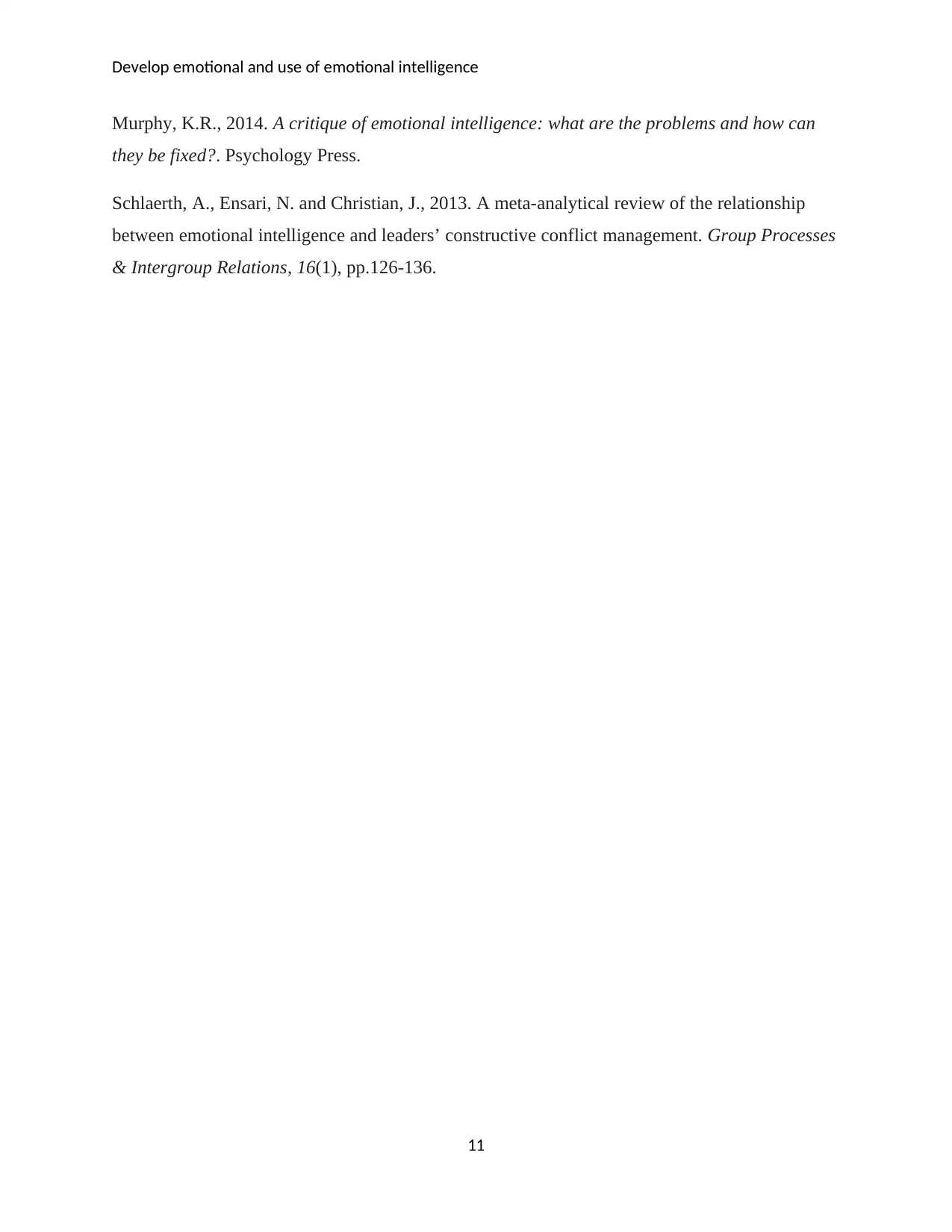
Develop emotional and use of emotional intelligence
Murphy, K.R., 2014. A critique of emotional intelligence: what are the problems and how can
they be fixed?. Psychology Press.
Schlaerth, A., Ensari, N. and Christian, J., 2013. A meta-analytical review of the relationship
between emotional intelligence and leaders’ constructive conflict management. Group Processes
& Intergroup Relations, 16(1), pp.126-136.
11
Murphy, K.R., 2014. A critique of emotional intelligence: what are the problems and how can
they be fixed?. Psychology Press.
Schlaerth, A., Ensari, N. and Christian, J., 2013. A meta-analytical review of the relationship
between emotional intelligence and leaders’ constructive conflict management. Group Processes
& Intergroup Relations, 16(1), pp.126-136.
11
1 out of 11
Related Documents
Your All-in-One AI-Powered Toolkit for Academic Success.
+13062052269
info@desklib.com
Available 24*7 on WhatsApp / Email
![[object Object]](/_next/static/media/star-bottom.7253800d.svg)
Unlock your academic potential
Copyright © 2020–2025 A2Z Services. All Rights Reserved. Developed and managed by ZUCOL.





